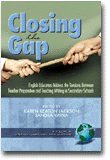
Closing the Gap
English Educators Address the Tensions Between Teacher Preparation and Teaching Writing in Secondary Schools
Edited by:
Karen Keaton Jackson, North Carolina Central University
Sandra Vavra, North Carolina Central University
A volume in the series: Literacy, Language and Learning. Editor(s): Claudia Finkbeiner, Universitaet Kassel. Wen Ma, Le Moyne College.
Published 2007
Without contraries there is no progression. ---William Blake
This is a book about reality and hope. Its chapters reframe the concept of gap, acknowledging distances (for example, acknowledging old insights and theory while also honoring teacher discovery). However, it refuses to bow under the weight of these challenges. Its contributors focus, instead on how to overcome acknowledged inadequacies in learning how to teach writing as well as how to practice principled literacy instruction. These contributors see gaps not as unbridgeable chasms, but rather as opportunities to educate their students to use writing to understand the broader context of their education and pre-service candidates to adapt curriculum creatively.
Contributors include new and seasoned secondary school teachers, graduate students, and university faculty who together remind us of “old insights needing to be passed along” (Villanueva) and show us new practices that challenge the conventions of the status quo and promote social justice. To close the gaps, in short, they demonstrate how rhetoric and truth are intertwined. In a time when too many children continue to be left behind, this book should be required reading for all literacy teachers because it is in our continued willingness to learn from each other that hope resides.
CONTENTS
Editors’ Notes: The Competing Rites and Methodological Rights of Teaching Writing, Foreword, Victor Villanueva, PART I Closing Gaps in Teacher
Preparation, Teaching Writing: A Matter of Identity, Disposition, and Standard Practice, Sandra Vavra and Sharon Spencer, Reflective Writing: Transforming Lives, Ideas, and the Future of English Education, Arlette Ingram Willis and Catherine D. Hunter, Teacher Advocacy in English Education, Amy Goodburn and April Lambert, Places of Possibility, Sites of Action: Reseeing the Gaps between High School and College Writing Instruction, Hephzibah Roskelly and Kathleen J. Ryan, Crossing Boundaries: English Education, Teaching Writing, and Connections to the “Real World”, Kia Jane Richmond, The Role of the National Writing Project in Closing the Gap between Teacher Preparation and Teaching Writing in Secondary Schools, Matthew Kilian McCurrie, PART II Closing Gaps in the Writing Classroom, Closing the Gap with Culturally Relevant Pedagogy in the Urban English Classroom, Patricia Ruggiano Schmidt and Kevin Salamone, “I Know I Can, Be What I Want to Be”: Using Rap Lyrics to Encourage Self-Reflection and Meaningful Writing from Students of Color, Karen Keaton Jackson, The Power of Their Texts: Using Hip Hop to Help Urban Students Meet NCTE/IRA National Standards For the English Language Arts, David E. Kirkland, Beyond Formulas: Closing the Gap Between Rigid Rules and Flexible Strategies for Student Writing, Chris M. Anson, Afterword: Success and the Status Quo, William Thelin, About the Contributors.
-
Paperback978-1-59311-781-8
Web price: $45.04 (Reg. 52.99)
-
Hardcover978-1-59311-782-5
Web price: $80.74 (Reg. 94.99)
- eBook9781607527442

- LAN015000 - LANGUAGE ARTS & DISCIPLINES: Rhetoric
- EDU015000 - EDUCATION: Higher
- EDU037000 - EDUCATION: Research
-
 Authentic Voices
Culturally Responsive Teaching and Learning
Authentic Voices
Culturally Responsive Teaching and Learning
-
 Collaborative Learning in a Global World
Collaborative Learning in a Global World
-
 Educational Practices in China, Korea, and the United States
Reflections from a Study Abroad Experience
Educational Practices in China, Korea, and the United States
Reflections from a Study Abroad Experience
-
 Innovative Approaches to Teaching Multilingual Students
Innovative Approaches to Teaching Multilingual Students
-
 Listening to the Voices of Boys
Exploring the Motivation of Primary Boys to Engage in Reading
Listening to the Voices of Boys
Exploring the Motivation of Primary Boys to Engage in Reading
-
 Reconceptualizing Literacy in the New Age of Multiculturalism and Pluralism
2nd Edition
Reconceptualizing Literacy in the New Age of Multiculturalism and Pluralism
2nd Edition
-
 Views from Inside
Languages, Cultures, and Schooling for K‐12 Educators
Views from Inside
Languages, Cultures, and Schooling for K‐12 Educators

